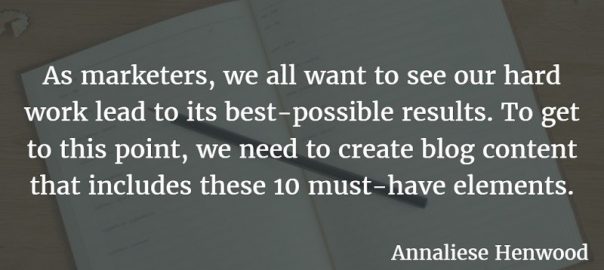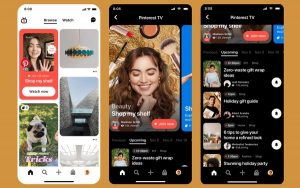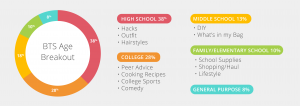So you have your blog established, but is it bringing the results you expected? If not, you may be missing one or more of these essential blog content elements.
Regardless of your years of experience or the amount of influence you may have, there’s always room for improvement. As marketers, we all want to see our hard work lead to its best-possible results. To get to this point, we need to create blog content that includes these 10 must-have elements.

By the time you get to the end of this article, you’ll be fully prepared to take on the blog-readership challenge: getting your readers to stick around long enough to convert. Join me as I lead you to blogging success.
— — —
1) A catchy but informative headline
When you’re creating your headline, it’s important you make it pop and appealing. However, you don’t want to be misleading. Why? That’s clickbait, and it annoys readers. You want visitors to stick around and hopefully follow-through on your call-to-action. If you use a misleading headline, you’re likely to both lose your visitors and convince them to never come back.
A catchy but informative headline will use a combination of emotional, powerful, and common / uncommon words. Use CoSchedule’s headline analyzer to evaluate your headline’s worth. You want to give people a reason to click through to your article, and appealing words can help. The only other part to keep in mind is that your headline should also tell people what your article’s value is to them.
2) An addicting introduction
You have mere seconds to grab your visitors’ attention after they land on your blog article’s page. You already convinced them to come based on your headline, but to keep them from bouncing away, you need a compelling introduction.
There are several ways to format your introduction to appeal to your readers. You can start with a question, such as how I did, to get people thinking. If you want people to crave more, try adding your article’s value proposition to your introduction. This means telling them why it’s important to stick around.
In addition to these approaches, make sure you tell your readers what they’ll get out of reading the article. Tell them why your article is worth their time. This will improve the likelihood that they’ll read through and, ideally, act on your call-to-action.
3) Scannable formatting
The human attention span is declining rapidly. People aren’t going to stick around if all they see is paragraph after paragraph. It’s essential that your content is formatted in a way that allows your readers to quickly scan it.
One way to create a scannable article is to include headings and subheadings. This article you’re reading now includes headings to list the different blog content items. Each section also has “further readings” to show you that there’s more to learn. These headings give you the ability to understand the gist of the article without having to read word for word.
Another way to format your article is to include bulleted lists. With this approach, you give your readers a break from the bulk text so that they can easily digest your points. It’s an effective way of listing related points about one subject so that readers quickly understand them.
4) Instructional images
Your blog content should always include visuals to break up the text you write. You’ll likely lose many potential readers if all they see on your page is text. Sometimes, all you need is a hero image near the beginning.
Here are a few pointers about inserting an image(s) into your article:
- Keep your images relevant to the article topic.
- Avoid stock imagery if you can afford to create your own.
- Add text overlay from within the article body to summarize your article’s main points.
Some web platforms give you the option to include a featured image that will appear when you share your article on social media. Use this to your advantage by including an image with text overlay. Let that text hook people in so that they click-through to your article.
5) Links of value and relevance
Another suggestion to add to your blog content elements is the incorporation of hyperlinks – both inbound and outbound. Adding links to other valuable resources, whether they’re yours or another site’s, can improve your article’s SEO.
Now, it’s important to keep in mind that your content should always be focused on benefiting your readers before search engines. Include hyperlinks that lead to other content that is both helpful to your audience and relevant to your article. This can be another blog post on your site, a landing page, or a product homepage you recommended. It doesn’t always need to be a content piece, but it should always be a site that increases your own article’s value to your readers.
6) Applicable instructions and next steps
When a reader comes to an article, they’re looking for information they can use, such as to solve a problem or “pain point.” Your best bet at optimizing your blog content is to provide a high-value end point for your readers.
This can be in the form of providing instructional information throughout the article. By giving your readers actionable advice, you’re making it easier for them to take what you’ve written and use it in their own work.
You can also take these instructions and form them into “next steps” in the conclusion of your article. Instead of leaving your readers hanging, give them something else to do with what they’ve learned. It’s important to note that this element of your article is not meant to be a call-to-action but rather more of a summary and value piece.
7) A reader-friendly social sharing system
Your blog content elements thus far have involved your content itself, but to gain more readers over time, you need people to share your work. Make this easy for them by incorporating a process within your article and also listing social sharing buttons somewhere on your page.
Within your article itself, you might want to consider using Click-to-Tweet or its alternative by CoSchedule. With these tools, you can add an in-text prompt that allows readers to share your article (or a quote from it) on Twitter with one click.
Another key part of your social sharing system should be the easy access to various button options. Depending on your audience, you want to include buttons for whichever social networks they might want to share on. You also want to consider adding buttons to Buffer, Hootsuite, bitly, and other social media tools. This will make your readers happy because it saves them a step.
One recommended social sharing system for your blog content is: Sumo. They have more tools available than just social sharing, and their services give you so many customization settings to fully optimize the process. For example: you can set the sharing bar to change order based on popular activity so that readers are more likely to share. It’s very handy.
8) A relevant Call-to-Action (CTA)
Earlier, you heard about instructions and next steps. Those aren’t your CTA. Instead, your CTA should lead your readers to a landing page, where they can fill out a form in exchange for something of additional value. This most often is an eBook or other free download. A CTA is what gets your readers to change from typical visitors to leads. CTAs are a lead generation tactic.
It’s important that your CTA be relevant to your blog content whenever possible. If you don’t have an additional resource to go along with an article, consider adding an email newsletter subscription form instead. However, you’ll want to have an additional resource of value as often as possible to increase your conversion rate.
Your CTA should be worded in a way that compels your readers to click-through to its corresponding landing page. It should visually stand out from the rest of your article – both via position on the page and imagery / coloring. Create a CTA that stands out by putting it in an image or its own colored box. You can learn more about creating optimized CTAs in the additional readings below.
9) Additional resources to accompany your content
In the section immediately above regarding calls-to-action, you learned that your blog content would greatly benefit from having an additional resource for readers. This resource would be gated behind a pop-up form or landing page, so readers would have to give you their contact information to get it.
One of the most effective ways to get readers to convert is by providing what’s called a “content upgrade.” This resource is often a cheat sheet, outline, or other quick reference that corresponds with the content at hand. It should be something that enhances the reader’s ability to apply what they’ve learned from your article.
It can also be something that people use while they read, such as a worksheet, where the answers are found within the article. It’s a great way to keep people reading from start to finish. Make this opportunity even better by turning it into something more interactive: offer an incentive to have people finish the worksheet within a certain time limit, for example.
10) Smart, unobtrusive sign-up forms
Part of having a blog is getting people to want to stay informed. You want to see people keep coming back for more. One of the blog content elements to consider adding is a sign-up form for your email newsletter. These can come in many forms:
- A pop-up notification while people read your article
- A widget in your article page’s sidebar
- A floating bar at the top or bottom of the page
- A drop-down full-page promotion
- And others…
Oftentimes, readers can find these sign-up forms interruptive and even frustrating. If the forms get in the way of the reader experience, you will see a higher bounce rate or, at best, a shorter time on the page. You have to be strategic with how you approach sign-up forms. Yes, they’re important, and yes, you want to grab attention with them. The only concern is whether your need is getting in the way of your reader’s need.
— — —
Putting it all together…
These blog content elements each have power in their own ways. To fully appreciate and reap rewards from them, you should consider applying them all with each article you write. You won’t always have that option, but it’s an ideal effort you should aim for as much as possible.
One final note of advice about optimizing your blog content:
You won’t be able to discover your blog’s full ROI potential unless you are researching and targeting the right audience. Reader personas are an essential backstory to your blogging efforts. Make sure you’re creating and updating them accordingly. This in-depth article gives you what you need for persona development.
What have we learned?
- The headline is the hook that brings your reader to your article. Make it catchy but relevant.
- Your introduction is what keeps your readers on the page. Create a paragraph or two that leaves your readers wanting to know more.
- Your article’s formatting gives your readers the ability to scan through the post without excess reading. Break up the text into headings, subheadings, and lists.
- Using images in your article gives readers a break from the text and can offer them a summary with optional text overlay. Add images that are relevant, high-quality, and even informative to help your readers digest the article’s content.
- When adding hyperlinks to your article, you’re enhancing your content for both reader and SEO benefits. Include internal and outbound links to give your content more authority and usefulness.
- Including a section(s) for instructions and / or next steps allows your readers to take what they’ve learned and apply it in their own lives. Provide step-by-step instructions whenever possible to help your readers with their own efforts.
- Your social sharing system is meant to give readers an easy means of spreading the word about your article and its contents with their own audience. Include a mix of sharing buttons and in-line quoting, and make sure you’re using a tool that optimizes this for you.
- Including a call-to-action (CTA) will give your content purpose in your quest for qualified conversions. Add a CTA that offers enough value to readers that they’ll be willing to share their contact information with you.
- When you want to see your readers convert and interact with your content, your best bet is to offer additional resources for them to download. Offer gated content that corresponds with your article somehow (a “content upgrade”) to help your readers while also giving you leads.
- Your sign-up forms aim to take readers from being visitors to becoming subscribers, and this tells you they’re interested. Instead of interrupting or annoying your readers with obtrusive forms, create an optimized system for how and when they will appear.
This article has given you the most important blog content elements with the purpose of bringing you closer to achieving your goals. Whether you want subscribers, qualified leads, or simply readers who stick around for the full length, this article should hopefully help when you apply it to your own site.
My purpose on this site is to provide actionable advice with proven results. It is my aim that each article I write gives my readers a good start or, even better, everything they need to take their own marketing efforts to the highest level.
So, when it comes to this article, how did I do? If you have any input on this article, whether it be a question or your own advice, leave a comment below. I’m sure everyone who has read to this point would appreciate other readers’ input.
Digital & Social Articles on Business 2 Community(65)








